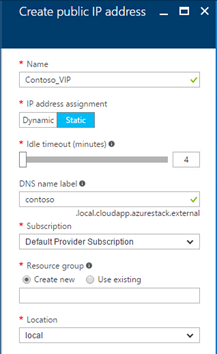Use DNS in Azure Stack Hub
Azure Stack Hub supports the following Azure DNS features:
- DNS hostname resolution.
- Create and manage DNS zones and records using the API.
Support for DNS hostname resolution
You can specify a DNS domain name label for public IP resources. Azure Stack Hub uses domainnamelabel.location.cloudapp.azurestack.external for the label name and maps it to the public IP address in Azure Stack Hub-managed DNS servers.
For example, if you create a public IP resource with contoso as a domain name label in the local Azure Stack Hub location, the fully qualified domain name (FQDN) contoso.local.cloudapp.azurestack.external resolves to the public IP address of the resource. You can use this FQDN to create a custom domain CNAME record that points to the public IP address in Azure Stack Hub.
For DNS resolution from outside the Azure Stack Hub, you can create a new zone with the public IP address instead of delegating the internal DNS zone. Otherwise, the clients won't have access to the IP address resolved by the Azure Stack Hub Infrastructure DNS servers.
To learn more about name resolution, see the DNS resolution.
Important
Each domain name label you create must be unique within its Azure Stack Hub location.
The following screenshot shows the Create public IP address dialog for creating a public IP address using the portal:

Example scenario
You have a load balancer processing requests from a web app. Behind the load balancer is a web site running on one or more virtual machines. You can access the load-balanced web site using a DNS name, instead of an IP address.
Create and manage DNS zones and records using the APIs
You can create and manage DNS zones and records in Azure Stack Hub.
Azure Stack Hub provides a DNS service similar to Azure, using APIs that are consistent with the Azure DNS APIs. By hosting your domains in Azure Stack Hub DNS, you can manage your DNS records using the same credentials, APIs, and tools. You can also use the same billing and support as your other Azure services.
The Azure Stack Hub DNS infrastructure is more compact than Azure. The size and location of an Azure Stack Hub deployment affects DNS scope, scale, and performance. This also means that performance, availability, global distribution, and high availability can vary from deployment to deployment.
Comparison with Azure DNS
DNS in Azure Stack Hub is similar to DNS in Azure, but there are a few important exceptions:
Does not support AAAA records: Azure Stack Hub doesn't support AAAA records because Azure Stack Hub does not support IPv6 addresses. This is a key difference between DNS in Azure and Azure Stack Hub.
Is not multi-tenant: The DNS Service in Azure Stack Hub is not multi-tenant. Tenants cannot create the same DNS zone. Only the first subscription that attempts to create the zone succeeds, and later requests fail. This is another key difference between Azure and Azure Stack Hub DNS.
Tags, metadata, and Etags: There are minor differences in the way Azure Stack Hub handles tags, metadata, Etags, and limits.
To learn more about Azure DNS, see DNS zones and records.
Tags
Azure Stack Hub DNS supports using Azure Resource Manager tags on DNS zone resources. It does not support tags on DNS record sets. As an alternative, metadata is supported on DNS record sets, as explained in the next section.
Metadata
As an alternative to record set tags, Azure Stack Hub DNS supports annotating record sets using metadata. Similar to tags, metadata enables you to associate name-value pairs with each record set. For example, metadata is useful to record the purpose of each record set. Unlike tags, you can't use metadata to provide a filtered view of your Azure bill, and metadata cannot be specified in an Azure Resource Manager policy.
Etags
Suppose two people or two processes try to modify a DNS record at the same time. Which one wins? And does the winner know that they've overwritten changes created by someone else?
Azure Stack Hub DNS uses Etags to safely handle concurrent changes to the same resource. Etags are different from Azure Resource Manager Tags. Each DNS resource (zone or record set) has an Etag associated with it. When a resource is retrieved, its Etag is also retrieved. When you update a resource, you can choose to pass back the Etag so Azure Stack Hub DNS can verify the Etag on the server matches. Since each update to a resource results in the Etag being regenerated, an Etag mismatch indicates a concurrent change has occurred. Etags can also be used when you create a new resource to ensure the resource does not already exist.
By default, Azure Stack Hub DNS PowerShell cmdlets use Etags to block concurrent changes to zones and record sets. You can use the optional -Overwrite switch to suppress Etag checks. With no Etag checks, any concurrent changes that have occurred are overwritten.
At the level of the Azure Stack Hub DNS REST API, Etags are specified using HTTP headers. Their behavior is described in the following table:
| Header | Behavior |
|---|---|
| None | PUT always succeeds (no Etag checks). |
| If-match | PUT only succeeds if resource exists and Etag matches. |
| If-match * | PUT only succeeds if resource exists. |
| If-none-match * | PUT only succeeds if resource doesn't exist. |
Limits
The following default limits apply when using Azure Stack Hub DNS:
| Resource | Default limit |
|---|---|
| Zones per subscription | 100 |
| Record sets per zone | 5000 |
| Records per record set | 20 |
Next steps
Feedback
Coming soon: Throughout 2024 we will be phasing out GitHub Issues as the feedback mechanism for content and replacing it with a new feedback system. For more information see: https://aka.ms/ContentUserFeedback.
Submit and view feedback for